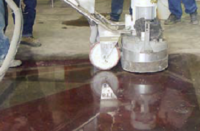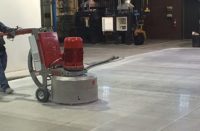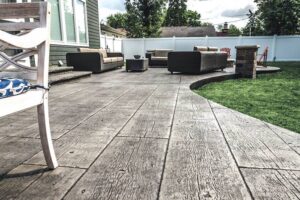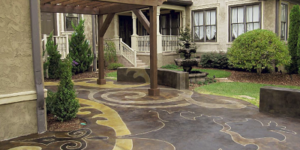
Samples, mock-ups and models take the guesswork out of decorative concrete finishes and offer a sense of security for the owner, designer and contractor. They quickly get everyone on the same page before crews permanently place any concrete on the site.
My company, Colorado Hardscapes Inc., and I are working on a project for a municipality in Colorado. As with any city project, multiple decision-makers with a variety of opinions oversee every step. Projects like this can be intimidating at first, which is one reason this situation reflects the importance of using samples, mock-ups and models.
This particular project involves installing a new toddler pool at an existing outdoor water play facility. Colorado Hardscapes’ portion of the job includes faux rockwork and specialty paving.
To begin, we created a maquette of the rockwork. “Maquette” is a French word meaning “scaled model,” and in fact, the word “mock-up” is an imitation of this. The landscape architect on this project started referring to it as a “French model” so he would remember.
I spent several weeks in the studio fine-tuning the maquette to match the audience, design intent, and character needed for the space. Meanwhile, Colorado Hardscapes’ rock artisans created a mock-up of the rock with the texture and color we intended to use on the feature.
Then the fun part began: Getting everyone on the same page. The general contractor added me to the agenda for the next owner, architect and contractor meeting. With an eager audience of eight people, I unveiled the maquette with a faux rock sitting right next to it. Both our maquette and our rock mock-up were a big hit. After some constructive dialogue and multiple camera shots, the excitement level rose even higher. More importantly, all parties involved knew exactly what the rocks would look like.
The city decided to keep the rock mock-up to help them determine colors for other items on the site. We took the maquette back to our shop to begin manufacturing.
Exploring possibilities with samples
Before the meeting ended, the landscape architect told me that we needed to talk about the design for the splash pad. The original design called for some etches in the concrete surface, but he wanted to know what other ideas Colorado Hardscapes might have.
Samples also helped us sell the new ideas as we went. I studied some of the renderings, listened to their dreams for the space, met with the landscape architect to show him some rough ideas and then came up with an excellent solution for him. However, the idea wasn’t something I could just pull off the shelf and show him. So he had to wait anxiously as I brainstormed with others at the office and in the shop until we fine-tuned the idea and created a sample.
Since this is an area for water play, there is an ocean aquatic theme throughout the entire site. To enhance that, I nestled some hidden crabs and starfish into the surface of the rockwork at eye level for toddlers to discover. The landscape architect wanted the splash pad to look as if some of the pool came up onto the “shore” and washed away some of the surface, leaving behind some playful tide pools, all the while maintaining a safe and flush surface. And of course, we had a budget we needed to stay within.
We developed a rough sketch and a sample showing our idea. To achieve the look, we utilized a series of wavy lines, saw cuts and broom-finished concrete. Colorado Hardscapes Sandscape, LithoMosaics with sea creatures and Lithocrete made of seashells, glass, and rock contributed to a cohesive look. When the landscape architect saw it, he was amazed — he did not know something like this was possible with concrete. He made my rough sketch look much more professional and took it and the sample to present to the city. Everyone loved the concept.
I received an email from one of the decision makers at the city stating, “I was able to see the sample for the spray ground — I love it!!! Exactly what I was imagining! Thank you for being so innovative with this project and making it a reality! I appreciate it!” Samples can communicate far more effectively than any drawing, written or verbal communication. Everyone is on the same page before the work even starts.
We work in an industry where a successful project is determined by whether or not it met expectations. If communication between the client and our crews gets distorted, frustration or disappointment is sure to follow. We do what we can to minimize these frustrations. Samples provide the visual communication tools which proposals, phone calls and even color charts cannot produce.
At Colorado Hardscapes, we are fortunate to have a working Design Center, where clients and designers can peruse an array of concrete samples. Almost every sample in our collection is a direct result of an actual or proposed project. We insist on creating a sample for every job we do, large or small.
Like all of our business practices, this concept evolved with the progression of Colorado Hardscapes. In the early 1980s, we started installing stamped concrete. Because decorative concrete was a relatively new concept back then, we found that samples were necessary to show clients what we proposed to install, as well as to clarify the installation for both the client and our crews. Colorado Hardscapes’ vice president, John Buteyn, remembers: “One catalyst for making (unique) samples for every job was when customers chose the color from one sample and the pattern from another. They convinced themselves that they had chosen the color and pattern from the same sample and believed that we had installed the wrong pattern.” By 1990, samples had become standard practice for us.
Creating samples stimulates the desire to try something new. Samples also provide artisans in the field with something they can reproduce.
Make it a habit to create a sample for every project, preferably in the design phase when working with a landscape architect or architect. Being in relationship with the design industry in the early stages of any project increases the likelihood you will be on the final project when it hits the streets. Even if you are not involved at prebid level, insist on samples once you are contracted. Get an approved sample, with the client signing off on color and texture, before placing any concrete.
Test your plan with mock-ups
Mock-ups are equally important, for both flatwork and interior concrete floors. Some flatwork jobs require an on-site mock-up. These are typically at least 100 square feet and show details relevant to the particular site. For exterior concrete, they will show expansion joints, saw cuts, and caulk where applicable. For interior concrete, they will show finish, saw cuts, caulk, patches, crack filling, edge details and any other requirements. For interior floors, especially if others place the concrete, we insist on doing a mock-up on-site. We typically perform this mock-up in a closet or a room where other floor coverings will cover it.
Also, we encourage the design community to insist on mock-ups from all of their decorative concrete contractors. Some contractors may see this as an unnecessary hassle — creating samples for every project or dream does take time and resources. But while we create our samples to help please the client and the design community, it is equally important for contractors to create samples for their own security.
Samples, mock-ups and models manage expectations. They show our crews what we promised the client, and they prove the finish is possible. Once we are equipped with these tools, second-guessing and misinterpretation of finishes, colors and details become things of the past.
Because of the importance of samples to every project we install, Colorado Hardscapes employs a full-time artisan devoted to creating samples. Our shop is set up for the fabrication of our samples with all of our sealers, materials and colors at her fingertips. Every sample she creates is labeled and then logged into a database with instructions and recipes on how to recreate it.
Whether you start with a full-time sample maker or utilize one of your skilled finishers as needed, if you are not doing samples, mock-ups or models now, I highly recommend you start.















